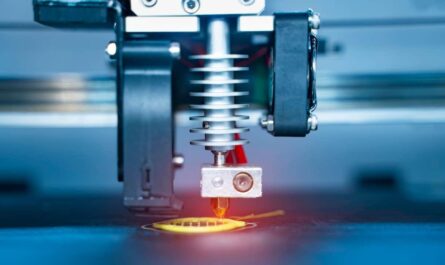A tunnel boring machine (TBM), also known as a “mole”, is a mechanical excavating machine used to excavate tunnels with a circular cross section through a variety of soil and rock strata. They can bore through anything from hard rock to sand. Modern TBMs can bore through softer ground at rates ranging from a few centimeters per hour to several meters per hour.
Working of a Tunnel Boring Machine Industry
TBMs can provide an effective and efficient means of excavating transport infrastructure such as roads, rail lines and water conveyance structures through various ground conditions including water saturated ground. A Global Tunnel Boring Machine works by using a circular cutter head at the front end of the main casing. This head has various cutter tools arranged radially all around it used for breaking the ground. Behind this head there are several functions like mucking system to remove the excavated material, shield system to provide ground support and line the tunnel with pre-cast concrete segments and thrust system to advance the machine forward.
Advantages of using TBM
TBMs provide many advantages over traditional drill-and-blast tunnel construction methods. They allow construction of smooth-walled tunnels in a more controlled environment. This reduces safety risks and prevents building damage above or near the tunnel. TBMs are capable of excavating through a variety of ground conditions including mixed-face conditions of soil, soft rock and harder rock strata with moderate hydraulic pressures. They are highly mechanized and automated which improves productivity by operating 24 hours a day without breaks. The excavated material is removed inside the shielded tunnel reducing dust and pollution hazards. Tunnel lining can be installed immediately after excavation improving ground stability.
TBMs in varied ground conditions
Depending on the geological conditions, different types of TBMs are used for tunnel excavation. For soft ground tunneling, the slurry TBMs are commonly used. These machines use pressurized slurry to support the tunnel face and transport the spoil to the rear. Earth pressure balance machines are suitable for heterogeneous ground conditions containing both soil and rock. For hard rock tunneling, the main TBM types are the single shield TBM and the double shield TBM. Single shield TBMs have the cutter head at the front while double shield TBMs useremotely controlled excavation drums behind a rear shield. Hybrid TBMs having adjustable operating modes are now increasingly being used for versatility in mixed ground tunnels.
largest TBMs in the world
Some of the largest diameter hard rock Global Tunnel Boring Machine include the Bertha, which had a diameter of 57.5 feet (17.5 m) used for the Highway 99 tunnel in Seattle, USA. The boring machine excavating the Lötschberg Base Tunnel in Switzerland between 1998 and 2006 had a diameter of 53 feet (16 m). The single largest hard rock TBM diameter is 60 feet (18.3 m) for the Chenab River Bridge road tunnel in India. Apart from size, breakthrough boring speed records are also being set by modern TBMs. The TBM named Joy used at the Gotthard Base Tunnel in Switzerland set a one-week hardness rock boring speed record in June 2011, averaging 59 feet (18 m) per day.
Future potential of TBMs
With increasing urbanization and demand for transportation infrastructure, the importance of mechanized tunneling is growing. New technological advancements in TBM design aim to develop machines capable of constructing even larger diameter tunnels at faster rates. Hybrid designs enabling excavation in varying ground and rock conditions would be more versatile. Concepts for wireless sensor based tunnel monitoring and automated mucking are being researched. Future TBMs might use alternative powerful cutting heads like drag bits, shields and raised cutters. Developing systems for complete remote operation and 3D mapping of tunnel faces could enhance safety. With further R&D, tunnel boring machines have huge potential to revolutionize underground construction globally.
Challenges for TBM application
While TBM tunneling offers high productivity and safety advantages, it also presents significant challenges. Geotechnical unpredictability during tunnel drive can lead to boring difficulties and project delays. Sudden geological faults or heterogeneous strata may cause difficulties in controlling groundwater ingress and maintaining operational stability. Underground obstructions like boulders also hinder continuous progress. Planning logistics of just-in-time TBM component replacement and maintenance at remote tunnel faces is complex. Proper ground treatment methods and accurate geological surveys are necessary to maximize TBM performance. Environmental regulations concerning effluent discharge further constrain some tunneling methods. Overall, successful TBM tunneling demands thorough risk assessment and mitigation planning.
Over the past few decades, tunnel boring machines have revolutionized underground transport infrastructure development globally. Modern hard-rock and soft-ground TBMs are capable of reliably excavating larger diameter tunnels at accelerated speeds through varied ground conditions. Besides construction productivity gains, TBM tunneling enhances worker safety and prevents building damage compared to traditional drill-and-blast methods. With ongoing technology innovations, tunnel boring machines have immense potential to construct expanding metro networks and highway systems worldwide in a sustainable manner. However, challenges relating to cost, geological unpredictability and logistical coordination also need addressing. Through innovative engineering solutions and risk management best practices, the capabilities of tunnel boring machines as a widespread tunnelling solution can be further optimized.
*Note:
1. Source: Coherent Market Insights, Public sources, Desk research
2. We have leveraged AI tools to mine information and compile it




